FACTS
1- The building is an HDFC
2- Maintenance charges is paid based on “room count”. Smaller apartments are paying the same maintenance that the larger apartments because they have the same “room count”.
3-There is a chart “Schedule A” that reflects the number of rooms, payment and shares.
4- Interior apartments (3, 5,9,12a,17 with 585 SQF and 4,6,10,14,18 with 613 SQF) are much smaller than exterior apartments (7,8,11,12,15,16,19,20,) with 835 SQF but pay the same maintenance. Pay maintenance by “room count” and 18 apartments pay as 5.5. However, the interior apartments that appears as 3 Bedrooms (5.5 rooms) are in reality 2Bedroom (4.5 rooms).
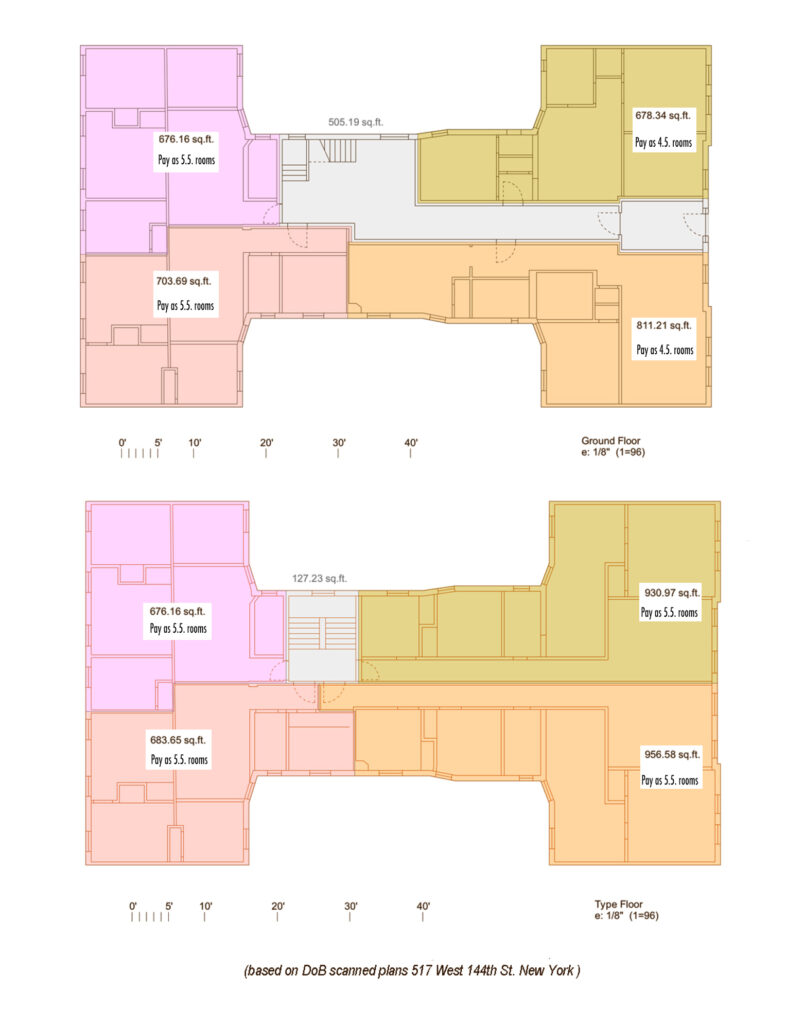
QUESTION
How can be possible that apartments with over 250SQF difference have the same room count.?
ANSWERS:
A) The “room count” a unit to measure space, how reliable it is is on question.
The size of an apartment can be measured with square feet or counting rooms (“room count”). But the “room count” is not a reliable unit to measure space.
During a meeting with Mr. Martin Rebholz (Borough Commissioner at the Department of Building at the Manhattan Borough Office), we looked at several floor plans and zoning regulations as they apply here. Mr. Rebholz made a copy of a floor plan and wrote one line: “the only existence of this 1 foot extension on each side of the door can change this apartment from having 4.5 or 5.5 “zoning rooms.”
He added that “this is a separate “zoning room” because it is separated with walls; the other is not a separated “zoning room” because it is separated with an arch, and not with walls.” Looking at the zoning resolution that applies to the building 1993, “Dining alcoves, dinettes or other dining spaces (without limit as to size) when not separated by walls or doors from other “living rooms” or cooking spaces, should not be counted as “living rooms” and due to the building code 28-105-4.2, removing a wall can be considered a minor alteration and no permission is required, so anybody can change the “zoning rooms” without filing permission…. “zoning rooms” are not supposed to measure size but safety and density…. the “zoning room” is not a reliable unit to measure the size of the room nor the maintenance.”
B) Renovations,often, mess up the room count
During the building renovations (1997) the room count was messed up. One architect Gilbert Dias did the interiors (Job 1009112XX), and another Paul Castruci (Job 1016660XX) did the exteriors. Before the renovations exterior apartments have a living room, a dining room, a kitchen and a bathroom plus 3 bedrooms; interior apartments have a living room, a dining room, a kitchen and a bathroom plus 2 bedrooms. After the renovations exterior apartments merged the living room with the dining into a single room (of 287 SQF), but in interior apartments the dining room disappears and was called a bedroom and the living rooms has only (130 SQF). Suddenly interior apartments have (5.5 Zoning rooms). Also the Certificate of Ocupancy must be changed when there is a change in room count, but no CO was filled.
The room count after renovations don’t follow the rules: “Room Count” shall be calculated in the following manner: The basic living space in a dwelling unit (a living room, dining area, and kitchen and bath) counts as 2 1/2 zoning rooms and every other room shall count as an additional room. There are rules of the minimum size for the dwelling unit over 230 SQF.
Irregularities on the plans for renovation. Alt 2 renovations with no change in room count, but the job was filled under Alt 1 when in reality should be filled as Alt1, that implies change in room count.
Irregularities on the plans for renovation. Alt 2 renovations with no change in room count, but the job was filled under Alt 1 when in reality should be filled as Alt1, that implies change in room count. 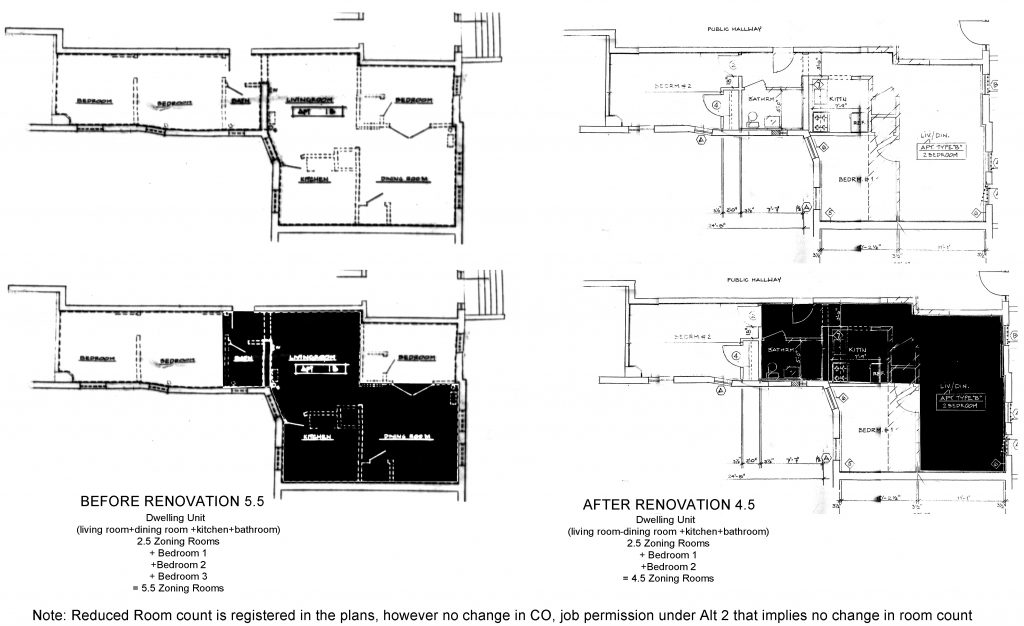
(7) Illustration: First floor apartment ZR reduced to 4.5 but no CO, filled as ALT1
Job 1016660XX, by architect Paul Castruci is filled as Alt2, (for change in room count is Alt1) but plans register room count change. No CO, but it must be changed when change in room count, but no CO filled. ZR were consider were the after renovations and not the before, the original layout of the building
If the renovation changed the walls with in the Dwelling unit, the room count is not changed. (sample exterior apartment in 4th floor)
– The dwelling unit attends the space not at its distribution: an open plan (kitchen, living room and dinning-room into the same area with no walls), or a close plan (walls to separate the kitchen from the living room or dinning area) have the same number of zoning rooms. When doing renovations in apartment, to close or open the kitchen don’t change the ZR.

(5) Illustration exterior apartment with open or close dwelling unit, before and after
If the renovation change the use of a room (for instance before was a dining room or a kitchen but the plan was changed and now it is a bedroom the walls with in the Dwelling unit, the room count is not changed.
(sample interior apartment in 3th floor dining room became a bedroom, the dwelling unit that suppose to have living room, dining area, kitchen and bathroom now is missing the dining room that appears as a bedroom)
(sample 2 interior apartment in 3th floor kitchen change place and became a bedroom, the dwelling unit that suppose to have living room, dining area, kitchen and bathroom now is missing the dining room that appears as a bedroom)
– The dwelling unit looks at the use (program), whether the room is use for sleeping or dining is more important. When doing renovations in apartment this is a crucial point.
Using the dining area as a bedroom change the number of zoning rooms.
To convert the kitchen into a bedroom changes the zoning rooms.
The size of the separation between two rooms changes the number of zoning rooms.
(6) Illustration: Reconstruction of interior apartment with kitchen where now is bedroom
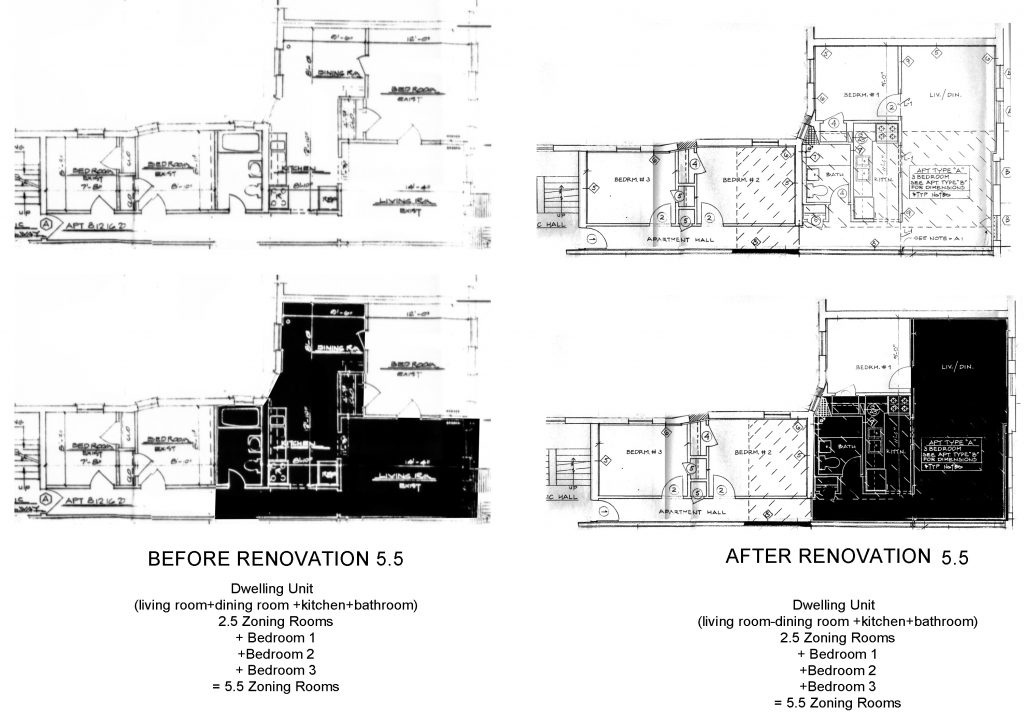

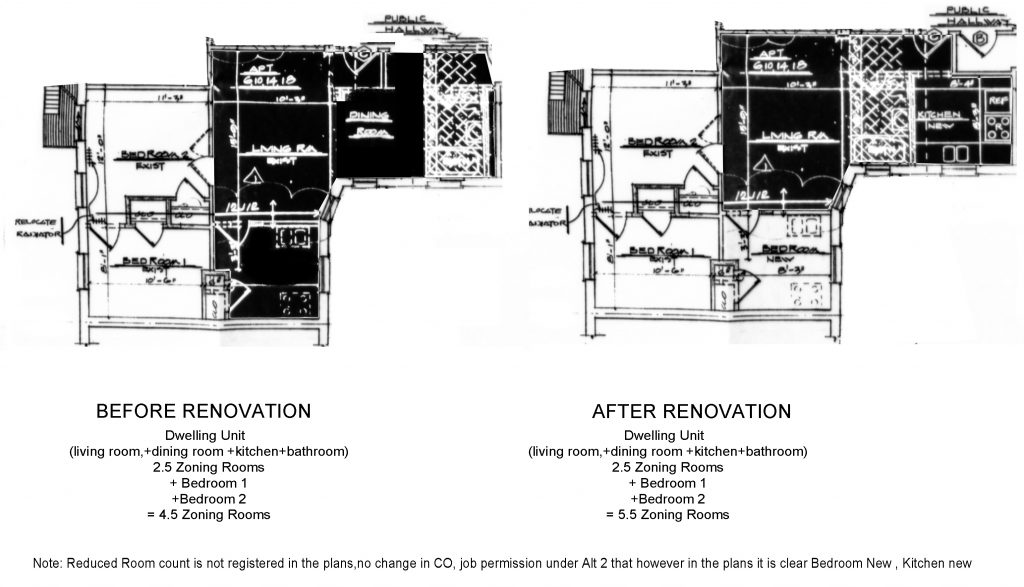

The building was sold and became a coop after renovation. In the Job title the client is the city of New York. HPD supposes to be checking the accuracy of all info before sent to contract.

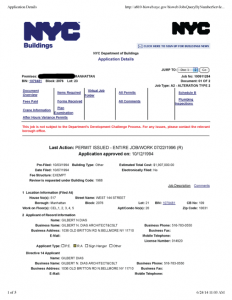
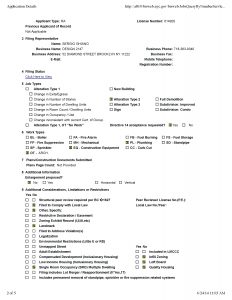
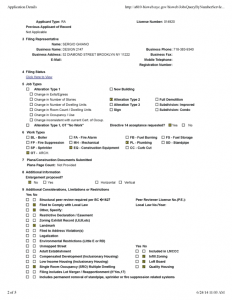
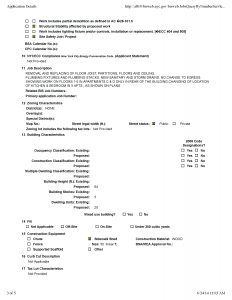
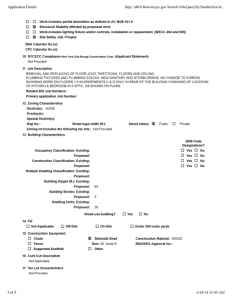
C) Calculating “room count” can be confusing and, as is turned out, HPD was confused when they calculated. HPD applied the wrong criteria to calculate
A ROOM IS NOT JUST SPACE INSIDE WALLS
Splitting from the same origin, the dwelling unit, (a living room, dining area, and kitchen and bath) the two ways in which a room is defined (Zoning room or room count) depends of the purpose of defining (structural or financial). In other words, it is the purpose what defines what is a room.
-Zoning Room (DoB)-estructural
-Room Count (Hpd)- financial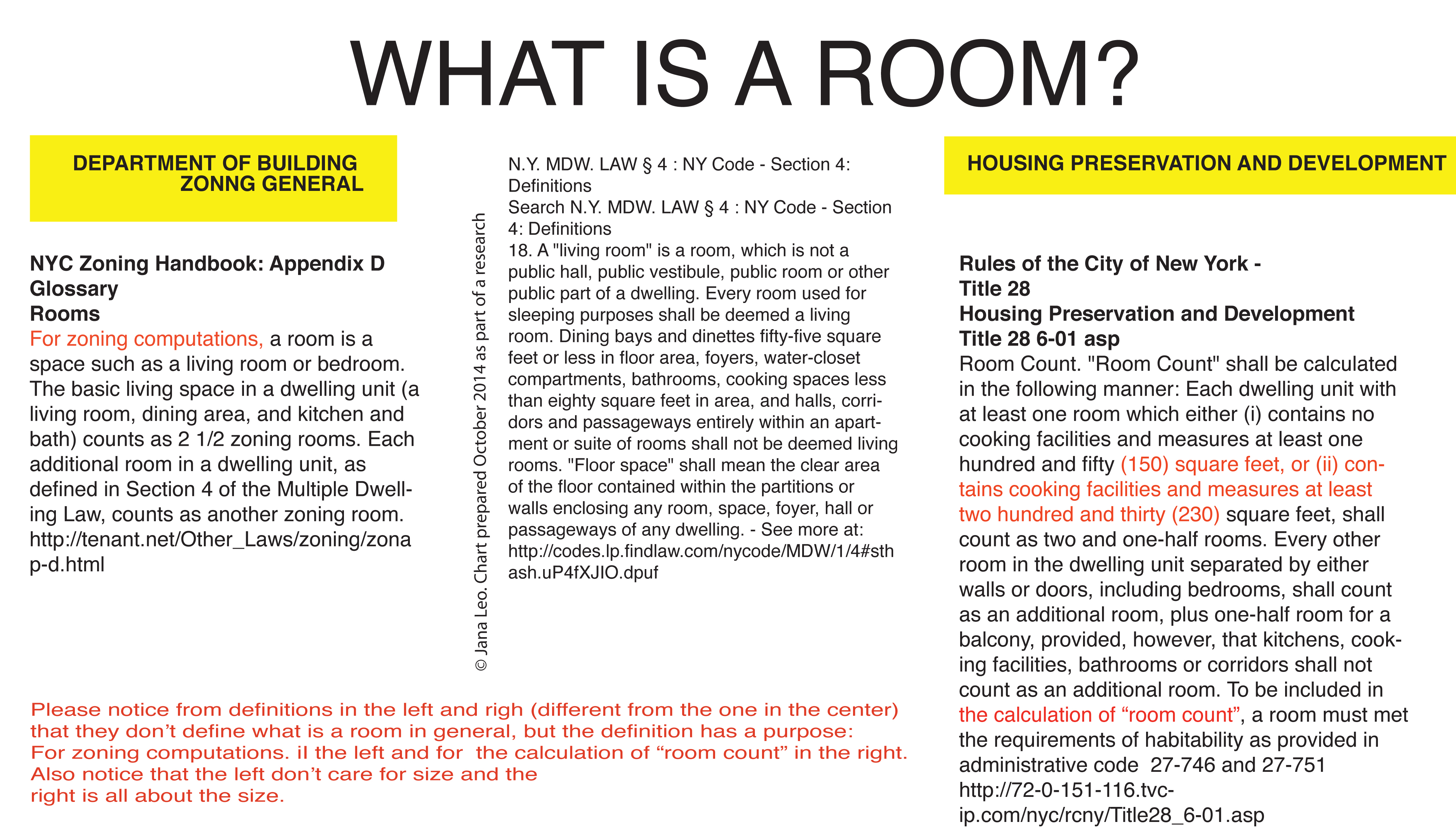
NYC Zoning Handbook: Appendix D
Glossary
Rooms
For zoning computations, a room is a space such as a living room or bedroom. The basic living space in a dwelling unit (a living room, dining area, and kitchen and bath) counts as 2 1/2 zoning rooms. Each additional room in a dwelling unit, as defined in Section 4 of the Multiple Dwelling Law, counts as another zoning room. http://tenant.net/Other_Laws/zoning/zonap-d.html
NYC Zoning Resolution 1993
Article 1: General Provisions
Chapter 2: Construction of Language and definitions.
Rooms
The number of “rooms” in a dwelling unit, for the purpose of complying with the lot area requirements, is computed in the following manner:
- a) The number of “living rooms” as defined in Section 4 of the Multiple Dwelling Law, is determined except that:
(1) Kitchens or other cooking spaces (without limit as to size) should not be counted as “living rooms”.
(2) Dining alcoves, dinettes or other dining spaces (without limit as to size) when not separated by walls or doors from other “living rooms” or cooking spaces, should not be counted as “living rooms”.
(3) Dining rooms in dwelling units containing three or more bedrooms, and one or more other living rooms as herein computed shall not be counted as “living rooms”, except that such dining rooms may be counted in determining the degree on non-compliance under the provisions of Section 54-31 (General provisions).
- b) The number of rooms to be counted in computing lot areas requirements is then determined the following table:
Number of “living rooms” Rooms
As computed in (a) above be counted
1 21/2
2 31/2
3 41/2
4 51/2
5 61/2
6 71/2
Additional 1 each.
The number of rooms in a rooming unit shall be counted as two.
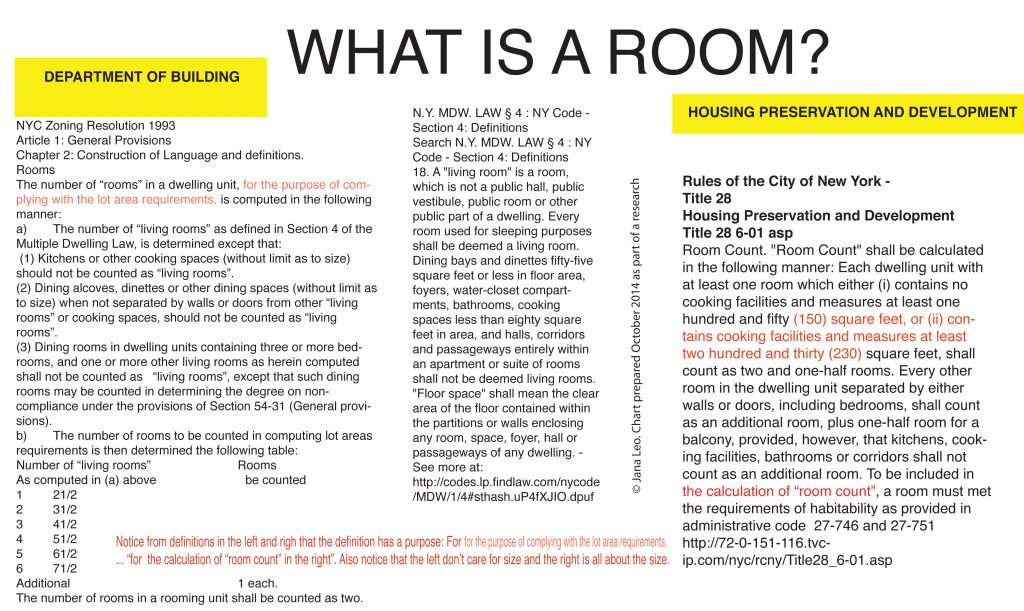
The dwelling unit implies that a room is a room for its use (for instance a dining room into a bedroom). Exact same thing, defining a room by what it is used for is shown bellow:
N.Y. MDW. LAW § 4 : NY Code – Section 4: Definitions
Search N.Y. MDW. LAW § 4 : NY Code – Section 4: Definitions
- A “living room” is a room, which is not a public hall, public vestibule, public room or other public part of a dwelling. Every room used for sleeping purposes shall be deemed a living room. Dining bays and dinettes fifty-five square feet or less in floor area, foyers, water-closet compartments, bathrooms, cooking spaces less than eighty square feet in area, and halls, corridors and passageways entirely within an apartment or suite of rooms shall not be deemed living rooms. “Floor space” shall mean the clear area of the floor contained within the partitions or walls enclosing any room, space, foyer, hall or passageways of any dwelling. – See more at:
http://codes.lp.findlaw.com/nycode/MDW/1/4#sthash.uP4fXJIO.dpuf
In contrast with the definitions above “for the purpose of complying with the lot area requirements” the one bellow “for the calculation of “room count”.
Rules of the City of New York –
Title 28
Housing Preservation and Development
Title 28 6-01 asp
Room Count. “Room Count” shall be calculated in the following manner: Each dwelling unit with at least one room which either (i) contains no cooking facilities and measures at least one hundred and fifty (150) square feet, or (ii) contains cooking facilities and measures at least two hundred and thirty (230) square feet, shall count as two and one-half rooms. Every other room in the dwelling unit separated by either walls or doors, including bedrooms, shall count as an additional room, plus one-half room for a balcony, provided, however, that kitchens, cooking facilities, bathrooms or corridors shall not count as an additional room. To be included in the calculation of “room count”, a room must met the requirements of habitability as provided in administrative code 27-746 and 27-751

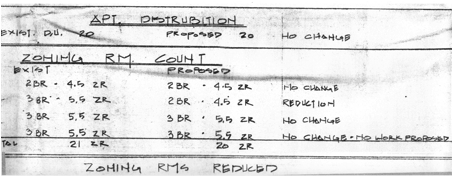
D) HPD didn’t use the right rules to measure rooms in HDFCs
Over a thousand HDFC buildings constituted between 1992 and 2003 have the wrong “room count” in their Schedule A.
The first time I asked officials from HPD about how rooms are counted for maintenance and the reason for half units such as 4.5 or 5.5, I was informed that each room counted as one and the bathroom counted as half. Looking at the plans, I felt that this was not a full explanation, which prompted deeper research on the “room count” issue. During the two-year course of my research, I looked at Schedule A in the offering plan of a building and I looked at the plans of that building before and after renovations. I can say with certainty that there was a match to the “zoning rooms” after renovations in the plans that I obtained from the Department of Buildings and the “room count” in Schedule A that that building was using to calculate maintenance. After the meeting with the DOB commissioner who clarified that “zoning rooms” don’t measure space,” I went in a different direction, looking again for the definition of a “room.” After another year of further research, I made a major discovery: room is defined by its intended use or purpose.
There are specific rules to define “room” depending on the purpose; there is “zoning room” and “room count;” There is “zoning room” and “room count” depending on the room’s purpose and for zoning calculation or maintenance. Some definitions take into account size; others don’t. Both “zoning room” and “room count” definitions use the dwelling unit (Living room + Dining area + Kitchen and Bathroom) that counts as 2 1/2 rooms; but whether the “zoning room” has no provision for the size of the dwelling unit, the “room count” has a provision for the size of the unit. Following Title 28 Housing Preservation and Development Title 28 6-01 asp, a dwelling unit that has cooking facilities must measure at least two hundred and thirty (230) square feet. [1]
Throughout my research, I was in communication with officials at HPD and kept them up-to-date on my findings. On several occasions, he also corroborated the fact that HPD did not measure the rooms, and, furthermore, that they didn’t look at the plans to determine the “room count.” Mr. Matthews told me that they went by 3BR=5.5; 2BR=4.5; 1BR=3.5, that is the base for a dwelling unit but not the definition of a “room count.”
Despite the fact that “room count” is defined in title 28 by HPD, and whether or not the purpose is different, when HPD did the calculations for Schedule A for HDFC, the “zoning room” from the Department of Building was used automatically to determine the “room count.” HPD didn’t use the right rules to measure rooms in HDFCs. As a result, all HDFC buildings constituted between 1992 and 2003 have the wrong “room count” in their Schedule A.
D) The room count and the SQF are both units to measure space
The main principle is that maintenance should be proportional to the size; whether the size is measure by room count or SQF the result should be equivalent. But is not, look at the charts with the different calculations.
Quite often, one finds different size apartments paying the same maintenance. For example, in one such building I’ve examined, there exists a 600 square foot apartment and a 800 square foot apartment, both with the same “room count” and, therefore, paying the same maintenance. Because smaller apartments tend to be less expensive and are frequently purchased by people with lower incomes, and, conversely, those with higher incomes purchase larger apartments, the resulting low-income wage earners subsidize the maintenance of the residents with higher incomes.
Evidence in support of this observation can be found by cross-checking charts in a building that is paying by room or by square foot: please see a sample chart showing maintenance calculation based on “room count” as appearing in the Offering Plan (Schedule A) for the building and another sample chart showing maintenance calculation based on square foot. For instance, a small apartment with the current “room count” calculation pays $525 but would pay $432 if paying by square foot; a large apartment with the current “room count” calculation currently pays $525 and will pay $606.
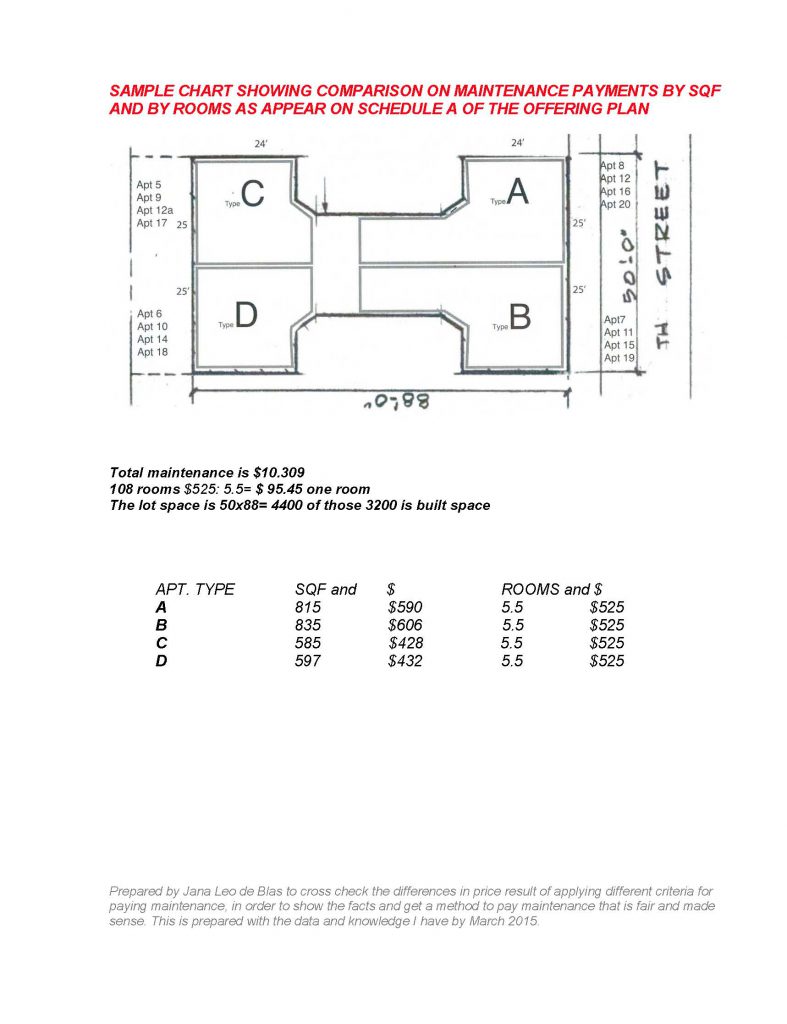
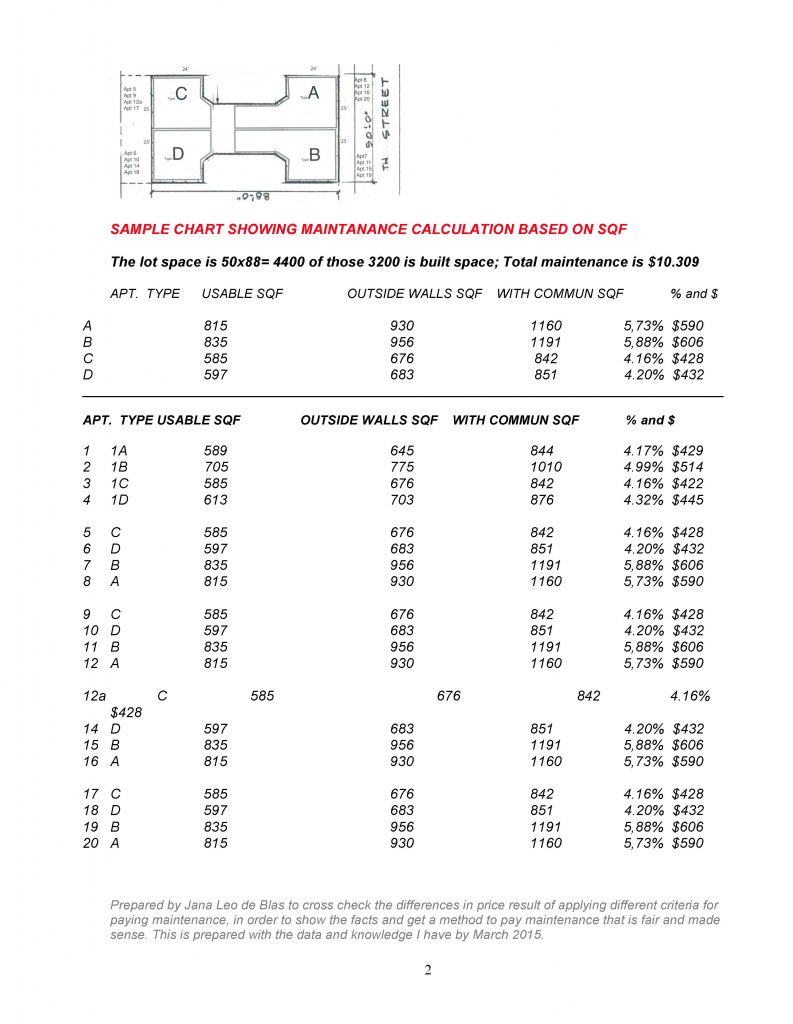
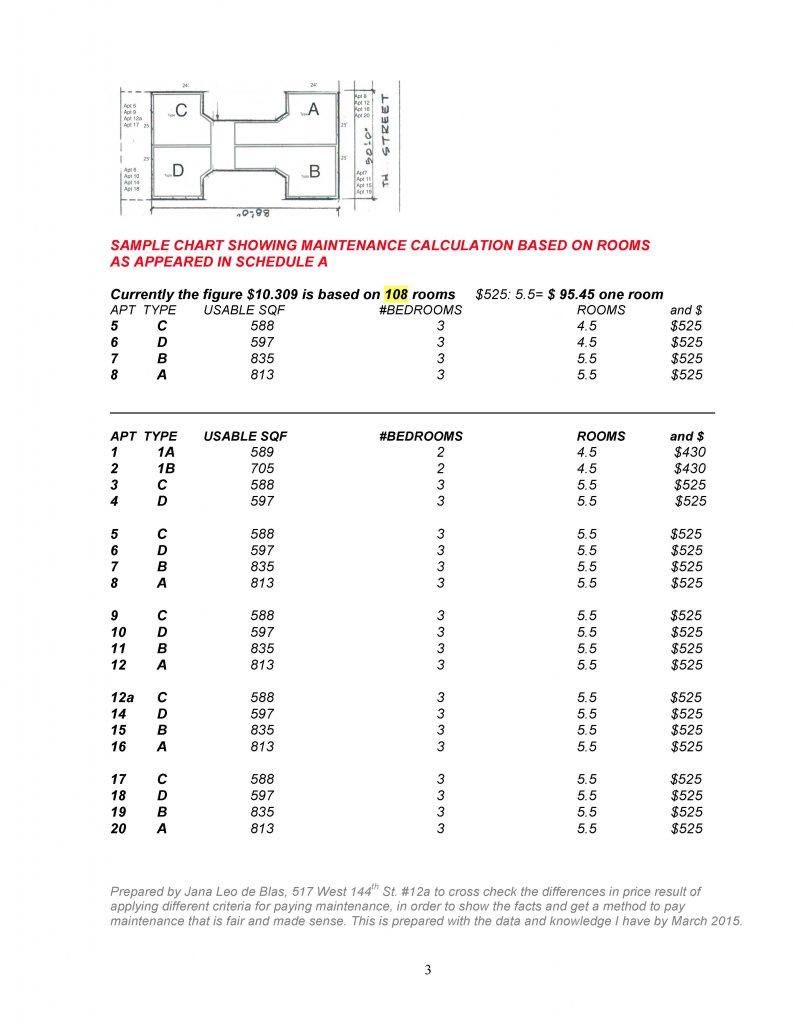
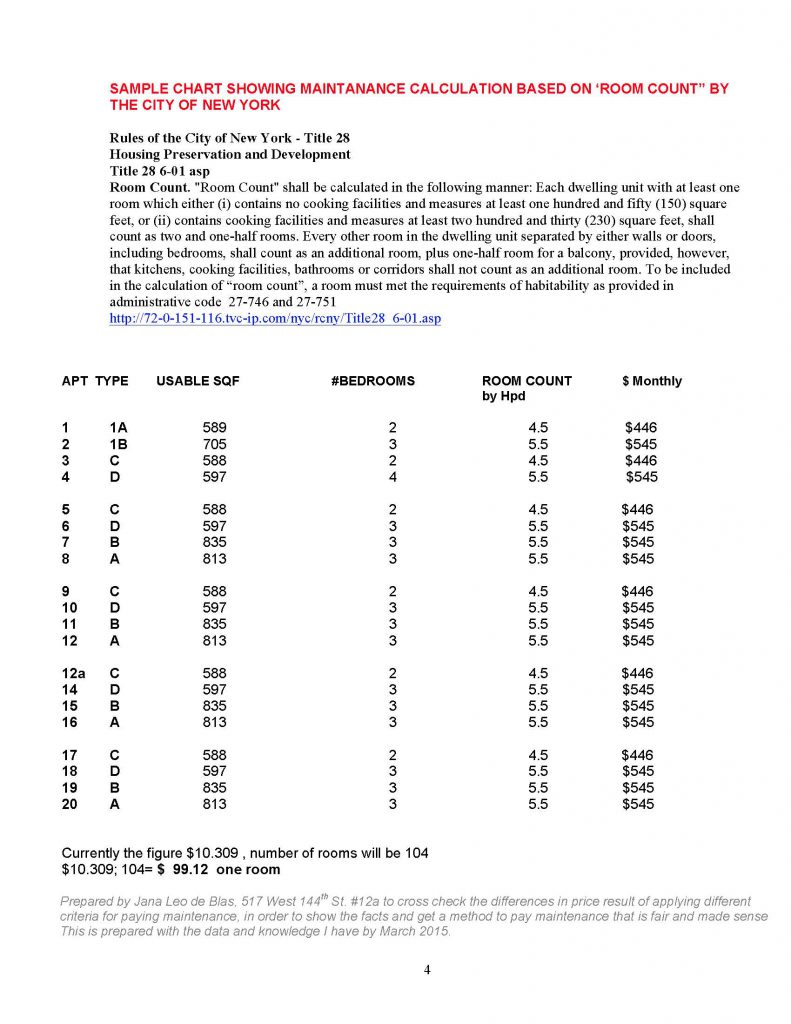
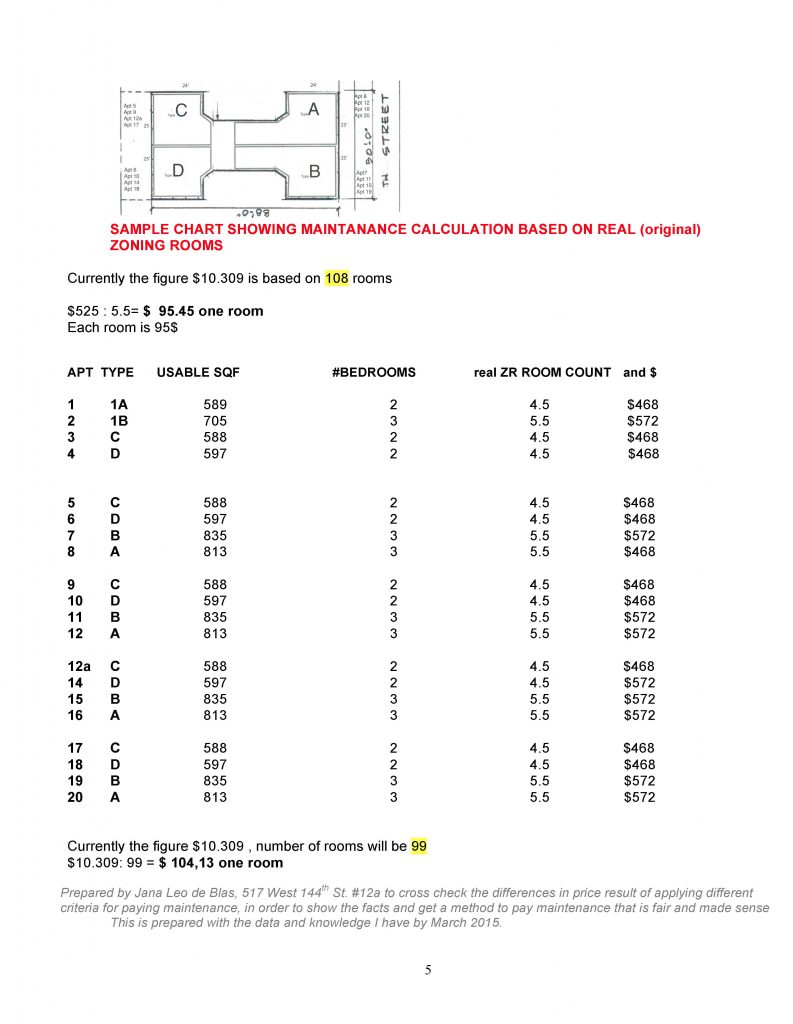
F) What a lawyer have to say?
When I was researching what is room I place the question in AVVO and this is what I get from Steven Smollens:
3/6/14 10:42 AM
There is a presumption of regularity in relation to cooperative conversions of
occupied housing accommodations, that an offering plan accepted for filing by
the New York Attorney General, complied with the rules in effect for making a
cooperative offering. Among the rules, and required for an offering plan for
occupied residential premises, is the creation of a table, known as Schedule ‘A’
where the following information must be disclosed (which includes rooms):
>>>18.3(f)
(1) Schedule A must appear on a separate page entitled “Schedule A and list the
following information for each apartment in columnar form. Column headings
may be shortened and abbreviated. Indicate that all projected charges are for a
stated 12-month period, e.g., January 1, 1983 to December 31, 1983. Totals
must be given for subparagraphs (iv)-(viii) of this paragraph: (i) unit
identification;
(ii) rent regulatory status of each unit, and which unit(s) is (are) vacant;
(iii) number of rooms (or usable space in square feet) and bathrooms;
(iv) share allocation;
(v) cash purchase price for each class of purchasers;
(vi) approximate amount of mortgage applicable to a block of shares (if
applicable);
(vii) projected maintenance charges for the first year of operation at $_____ per
share (annual and monthly);
(viii) projected annual income tax deduction at $_____ per share for the first year
of operation (if applicable).
(2) Shares must be allocated in whole shares.
(3) Detailed footnotes must support and explain the information in Schedule A.
These footnotes must include, but are not limited to the following:
(i) For the number of rooms, state the method of calculating the number of
rooms in each unit. If rooms are calculated in accordance with an industry standard, it is
sufficient to refer to the industry standard employed.
(ii) For the share allocation, explain the basis for the allocation of shares in the
particular building.
(iii) For the cash purchase price, explain any differences in prices to classes of
purchasers.>>>
http://www.ag.ny.gov/sites/default/files/pdfs/b…
Whenever the original plan was accepted for filing, the method used to
determine the number of rooms overall and in each offered unit, met the legal
criteria in effect at the time of the acceptance of the plan. The Offering Plan must
contain affirmative statements from Sponsor as well as other persons, that the
facts stated in the Offering Plan are correct and not misleading. For a citysponsored
H.F.D.C. the sponsor is a commissioner of the Department of Housing and Community Renewal.
“>>>18.4(a) We have read the entire offering plan. We have investigated the
facts set forth in the offering plan and the underlying facts. We have exercised due diligence to form
a basis for this certification. We jointly and severally certify that the offering plan does,
and that documents submitted hereafter by us which amend or supplement the offering
plan will:
(i) set forth the detailed terms of the transaction and be complete, current and
accurate;
(ii) afford potential investors, purchasers and participants an adequate basis
upon which to found their judgment;
(iii) not omit any material fact;
(iv) not contain any untrue statement of a material fact; (v) not contain any fraud,
deception, concealment, suppression, false pretense or
fictitious or pretended purchase or sale;
(vi) not contain any promise or representation as to the future which is beyond
reasonable expectation or unwarranted by existing circumstances;
(vii) not contain any representation or statement which is false, where I/we:
(a) knew the truth;
(b) with reasonable effort could have known the truth;
(c) made no reasonable effort to ascertain the truth; or
(d) did not have knowledge concerning the representations or statement made.
This certification is made under penalty of perjury for the benefit of all persons
to whom this offer is made.>>>”
Research by Jana Leo
© Jana Leo
Non of the information or documentation can be used without asking writing permission to the author.
